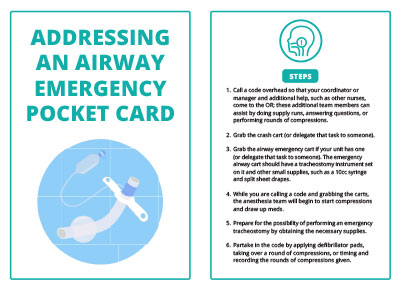Navigating an Airway Emergency as an RN Circulator
By: Megan McHugh, BSN, RN
Published: 11/29/2023
Patients most at risk for an intraoperative airway emergency include older adults and patients with tracheal stenosis, a history of previous tracheostomy/airway surgery or difficult intubation, or large airway tumors. Intraoperatively, the signs and symptoms of an airway emergency are increasing heart rate, decreasing pulse oximetry, and a decreased end-tidal carbon dioxide. When an airway emergency occurs, you must stay calm; you cannot help anyone when you are in a panic.
Steps to Address an Airway Emergency
- Call a code overhead so that your coordinator or manager and additional help, such as other nurses, come to the OR; these additional team members can assist by doing supply runs, answering questions, or performing rounds of compressions.
- Grab the crash cart (or delegate that task to someone).
- Grab the airway emergency cart if your unit has one (or delegate that task to someone). The emergency airway cart should have a tracheostomy instrument set on it and other small supplies, such as a 10cc syringe and split sheet drapes.
- While you are calling a code and grabbing the carts, the anesthesia team will begin to start compressions and draw up meds.
- Prepare for the possibility of performing an emergency tracheostomy by obtaining the necessary supplies (see below).
- Partake in the code by applying defibrillator pads, taking over a round of compressions, or timing and recording the rounds of compressions given.
Tracheostomy Supplies
To perform a tracheostomy, you will need a tracheostomy instrument set that includes a trachea hook and spreader. You will also need a hand-activated or foot-activated electrosurgical device (you may need a foot pedal or a special adapter for it to work with your generator) and generator device, multiple sizes of tracheostomy tubes, a 10cc syringe, and at least one (possibly two) working suctions. The two most crucial instruments are the trachea hook and spreader. If your instrument set does not have them, you should obtain them in individual packages (for example, in a peel pouch). If you do not have a tracheostomy instrument set available, you also will need curved Mayo scissors, Army-Navy and Senn retractors, a knife handle, suction tips, Schnidt forceps, and needle holders.
Testing the Tube
The scrub person should test the tracheostomy tube anytime there is one on the sterile field, preferably before the patient enters the room (or, at a minimum, ASAP when an airway emergency occurs). This is done by submerging it in saline, inflating the balloon with 10cc of air, and observing for air bubbles leaving the cuff. If air bubbles are present, the tube is nonfunctional and a new one is needed. It is important to restock the tracheostomy cuff that you used, so that it is available for the next airway emergency.


